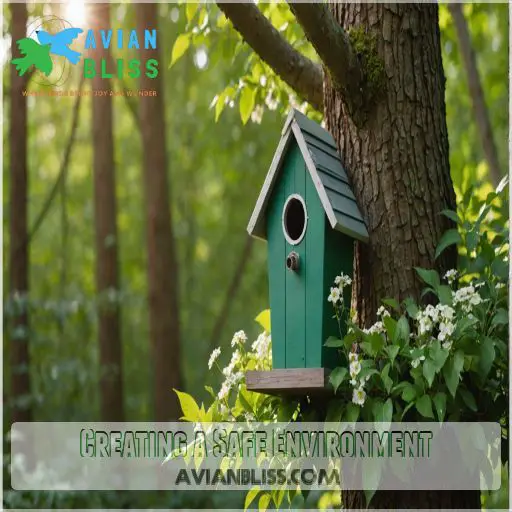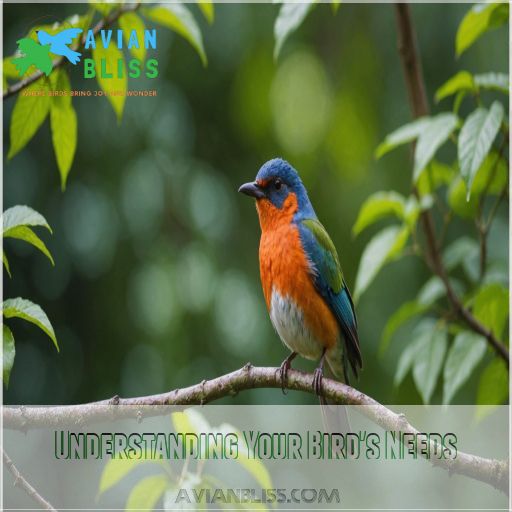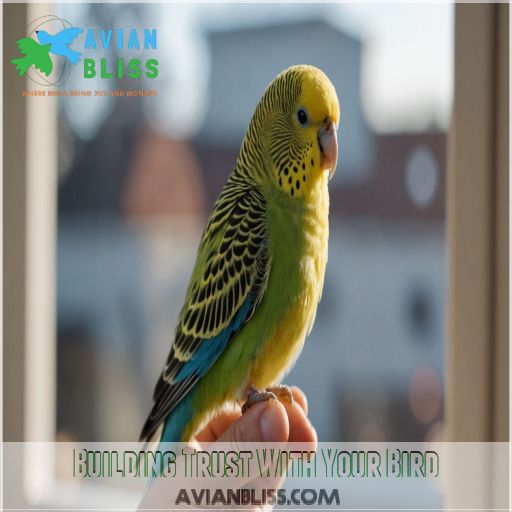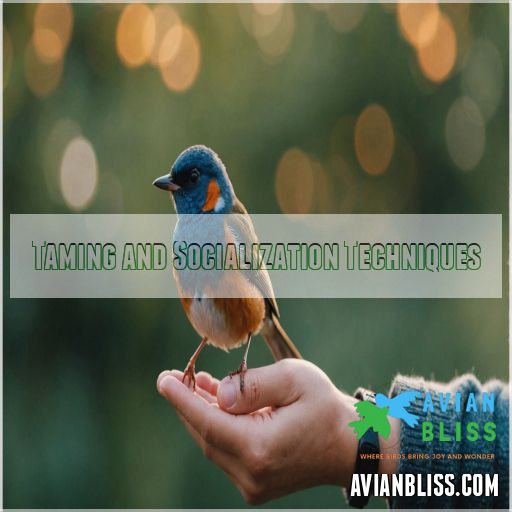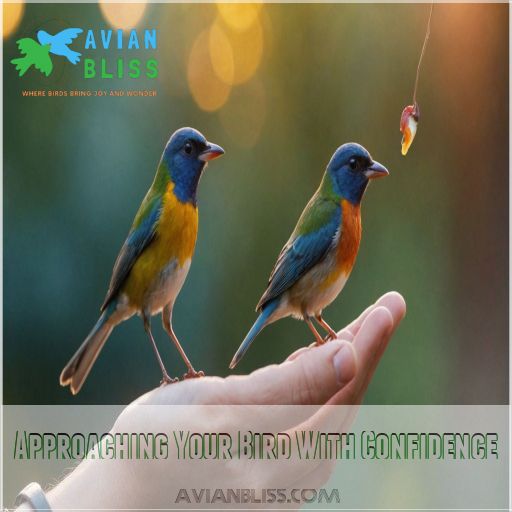This site is supported by our readers. We may earn a commission, at no cost to you, if you purchase through links.
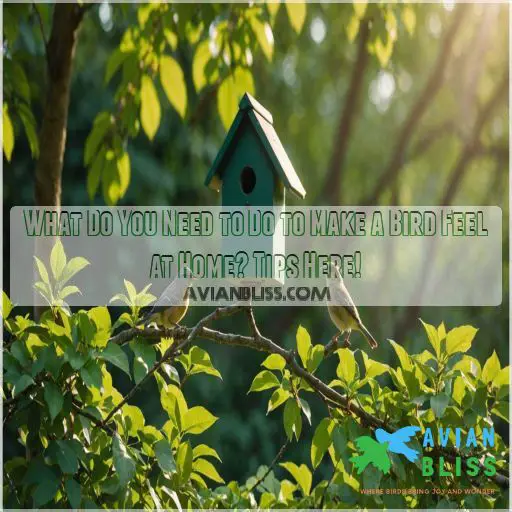
Offer a variety of engaging toys to keep it entertained and a spacious, clean cage with comfy perches. Recognize signs of stress, like ruffled feathers or a lack of chirping, and provide a balanced diet with fresh water.
Regular flight and exercise are key—let your feathered friend stretch those wings like a Pine Siskin! building trust takes patience; speak softly, offer treats, and avoid sudden movements. Establish routines to bring comfort.
It’s all about meeting their unique needs! Curious for more feathered tips?
Table Of Contents
- Key Takeaways
- Creating a Safe Environment
- Understanding Your Bird’s Needs
- Building Trust With Your Bird
- Establishing a Daily Routine
- Taming and Socialization Techniques
- Approaching Your Bird With Confidence
- Handling Fearful or Hostile Birds
- Providing Mental Stimulation and Playtime
- Building a Strong Bond With Your Bird
- Frequently Asked Questions (FAQs)
- How do you make a bird feel at home?
- How to make a wild bird feel safe?
- How to make your bird feel safe?
- How to make a wild bird trust you?
- How long does a bird usually live?
- What are signs of a sick bird?
- How can I prevent bird boredom in a cage?
- What should I do if a bird escapes?
- How to introduce a bird to other pets?
- Conclusion
Key Takeaways
- Create a "cozy sanctuary" by keeping your bird’s environment calm and quiet. Just like you’d want a peaceful yoga retreat, your bird needs a stress-free zone with minimal noise to feel secure and content.
- Offer a buffet of fun with a variety of engaging toys and mental stimulation. Birds are curious and clever, so mix up their playtime with puzzles and interactive games to keep them entertained and their minds sharp.
- Build trust and friendship with patience and treats. Think of it as extending an olive branch—gentle words and the occasional seed or fruity delight can work wonders in making your bird see you as a friend, not a giant with claws.
- Establish routines that would make any bird feel like they’re living the high life. Regular feeding times, exercise, and sleep schedules provide structure and security, turning your space into their personal playground.
Creating a Safe Environment
Creating a safe environment for your bird isn’t just about setting up a comfortable cage—keeping loud noises to a minimum and providing a variety of engaging toys can make your feathered friend feel more at home. You can also make sure you are offering the right foods, like a balanced diet, to keep them healthy and happy.
Make sure the cage is clean and roomy, with comfy perches, and you’ll soon find your bird feeling more secure and chirpy!
Avoiding Loud Noises and Stressful Situations
Loud noises can really rattle your feathered friend.
Think of their home as a cozy sanctuary – a safe haven from the hustle and bustle.
Keep the volume low, whether it’s the TV, music, or even your own voice.
A calm, peaceful environment will help your bird feel secure and content.
Providing a Variety of Toys and Stimulation
Just like humans, birds love variety and fun in their lives.
After avoiding noisy environments, turn your attention to toys for mental enrichment.
Choose bird-specific options for safety and joy.
- Foraging toys to mimic natural behavior
- DIY toys with household items
- Interactive bird toys for taming
- Brightly colored bird enrichment tools
- Watch them to gauge their enthusiasm
Maintaining a Clean and Spacious Cage
Keeping a clean and spacious bird cage is like giving your feathered friend a comfortable home, just like choosing the right bird feeder type can attract a variety of birds.
Regular cleaning of their bird habitats helps maintain good health.
Use safe materials and arrange toys wisely to maximize space.
With proper bird care, you’ll create a welcoming environment, making your bird feel secure and happy – and isn’t that what we all want for our pets?
Offering a Comfortable Perch and Social Area
While maintaining a clean, spacious bird cage, make sure your feathered friend feels comfy with the the right perch size and placement.
Think of it as their personal lounge chair!
A cozy social area filled with bird accessories and social toys will foster bird friendship and trust.
A well-thought-out cage layout helps mimic bird behavior and turns your home into their sweet haven.
Understanding Your Bird’s Needs
To make your feathered friend feel right at home, it’s important to understand their unique needs.
Pay close attention to signs of stress, provide a balanced diet, and offer plenty of opportunities for flight and mental stimulation. (Source)
Recognizing Signs of Stress and Anxiety
Spotting stress in your feathered friend is important for building a happy home.
Look for:
- Feather Ruffling: A stressed bird often ruffles its feathers excessively.
- Puffed-Up Chest and Hiding: Signals anxiety, especially if paired with unusual vocalizations.
- Aggression: A fearful or hostile bird might lash out.
Help your bird settle in with patience and bird bonding activities.
Providing a Balanced Diet and Fresh Water
Providing your bird with a balanced diet and fresh water is as important as a fish needing water or a cat purring contently.
Explore diverse bird food types and emphasize hydration importance.
| Bird food types | Water bowl choices | Dietary supplements |
|---|---|---|
| Seeds | Stainless steel | Vitamins |
| Pellets | Plastic (BPA-free) | Calcium |
| Fruits | Ceramic | Omega-3 |
| Vegetables | Stoneware | Probiotics |
Offering Opportunities for Flight and Exercise
Birds need space to spread their wings and soar.
A large flight cage or an indoor flight space works wonders.
If you’re feeling adventurous, consider safe outdoor flight, but always supervise.
Spruce things up with exercise toys and flight training.
Watch your feathered friend’s joy take flight—literally during the dawn chorus!
Join bird owner communities for more advice and share the love.
Providing Mental Stimulation and Social Interaction
While birds are naturally curious and intelligent creatures, they also crave mental stimulation and social interaction.
Offer a variety of engaging toys, puzzles, and foraging opportunities to challenge their minds.
Additionally, spend quality time with your feathered friend, as birds are highly social and thrive on positive human interaction.
- Provide interactive toys that encourage problem-solving and exploration.
- Engage your bird in regular playtime, allowing them to showcase their unique personality.
- Observe your bird’s communication and body language to better understand their needs.
Building Trust With Your Bird
To make your bird feel truly at home, start by building trust using soft, calm tones and avoiding sudden movements, as birds appreciate a gentle touch.
Imagine offering your feathered friend its favorite treat like you’re delivering a peace offering, creating a bond stronger than peanut butter to jelly, like sharing a safe snack.
Speaking Softly and Calmly to Your Bird
When building trust with your bird, remember that gentle handling and a calm voice can be magic wands!
Bird communication relies heavily on your vocalization impact.
Speaking softly lets your bird know you’re a friend, not a foe.
With empathy and patience, you’ll soon find that your bird starts responding.
It’s like opening a door to a new friendship.
Avoiding Sudden Movements and Loud Noises
Ever notice how a sudden sound can make your heart jump? Birds are just as sensitive, so building trust involves minimizing startling noises and movements.
With your feathered friend in mind:
- Speak softly.
- Move slowly and deliberately.
- Avoid banging objects.
- Keep volume low on electronics.
- Approach calmly.
Creating a peaceful home shows bird owner affection and respect.
Offering Favorite Treats and Rewards
Offering your feathered friend their favorite treats is a surefire way to build trust and strengthen your bond.
Whether it’s a crunchy seed or a juicy berry, use these tasty morsels as rewards for good behavior and to encourage interaction.
Your bird will soon associate you with positive experiences and feel more at ease in your presence.
Providing Comfort and Security Outside the Cage
To make your bird feel at home, treat time leads to outside comfort and security.
Create safe, quiet spaces with bird-safe furniture, ensuring proper perch placement.
Imagine the bird as your little buddy exploring a comfy zone.
Positive reinforcement is key—bird experts at your service!
Join bird owner education and fly high, together!
Establishing a Daily Routine
To make your bird feel at home, establish a daily routine that includes scheduled feeding times and regular play, ensuring that they’ve structured moments for both exercise and socialization.
This helps your bird’s physical health but also provides mental stimulation and a consistent sleep schedule, helping them feel secure and content.
Creating a Schedule for Feeding and Socialization
Consistency is key to making your pet bird feel at home.
Create a feeding schedule that aligns with your bird’s natural mealtimes.
Mix socialization routines into your day, forming a bird-owner relationship.
Include training time for learning tricks and playtime schedules to make sure fun is part of the routine.
Understanding bird behavior helps choose the right bird products.
Balance routine and spontaneity for happy bird species!
Providing Regular Opportunities for Flight and Exercise
Giving your feathered friend regular opportunities to stretch their wings and get some exercise is really important for their physical and mental well-being.
You can create a safe, spacious flight cage, set up an indoor aviary, or allow supervised outdoor time in a secure area.
Don’t forget to provide plenty of engaging toys to keep them active and entertained!
- Bird flight cages
- Indoor aviaries
- Safe outdoor spaces
- Exercise toys
Maintaining a Consistent Sleep Schedule
Every bird thrives with a consistent sleep schedule, much like we do! Covering their cage helps their birdie dreams, as they synchronize with natural light, cultivating trust. Light impacts their sleep cycles.
Consider the following tips for optimizing your bird’s rest:
| Tip | Description | Benefits |
|---|---|---|
| Cage covering | Dark cloth over the cage | Reduces light |
| Quiet time | Lower noise levels at night | Promotes calm |
| Sleep patterns | Establish a bedtime routine | Promotes rest |
| Bird owner commitment | Stick to schedules | Builds trust |
| Birds light | Match with day/night cycle | Natural rhythm |
Offering Mental Stimulation and Playtime
After your bird’s restful snooze, it’s game time! Keep their minds nimble and entertained by offering:
- Bird puzzles: Challenge their cleverness with intriguing brainteasers.
- Foraging toys: Make snack times an adventure.
- Interactive games: Play together, strengthening your bond like peanut butter and jelly.
Taming and Socialization Techniques
When you’re ready to tame your bird, imagine becoming their friendly, featherless roomie with treats in hand.
You’ll find they’re more likely to step up—literally—if you create a calm, cozy environment and use positive reinforcement.
Wing Clipping and Preparing for Taming
Before you start taming your new feathered friend, it’s important to clip their wings.
This will help them feel more secure during the process.
Gather some treats, a towel, and two wooden dowels – these will be your trusty taming tools.
Stay calm and patient as you slowly build trust with your bird through positive reinforcement.
Choosing a Quiet and Safe Taming Room
Once you’ve prepared to begin taming, choosing a quiet and safe taming room is key.
Opt for a small room with bird-safe materials and minimal furniture, preventing mishaps.
Consider these steps:
- Noise Reduction: Use rugs or curtains to muffle sounds.
- Ideal Room Size: Cozy yet spacious enough for flight.
- Furniture Removal: Clear distractions for focused training.
Using Treats and Positive Reinforcement
Treat training is like a golden ticket to your bird’s heart.
You’ve got to play it smart with the reward system!
Use clicker training or a gentle “good job” to reinforce positive discipline for perfect bird behavior.
Think of treats as little high-fives for a job well done—just don’t overdo it.
Treats should be special!
Teaching Basic Commands and Tricks
You’ve got your treats ready, so let’s teach your bird some neat tricks. Introducing basic commands enhances bonding and understanding. Use clicker training and target training to guide your bird gently. Try words like "up" for stepping on your hand.
- Set achievable goals.
- Make sessions short and fun.
- Celebrate small victories.
- Provide positive reinforcement.
Approaching Your Bird With Confidence
Approaching your feathered friend with confidence is key to building trust.
Project a calm, relaxed demeanor as you walk up to your bird with your hands behind your back.
Then gently extend your hand with fingers straight and thumb down to invite them to step up.
Projecting Calmness and Confidence
Confidence, much like a good birdseed, is key. Your feathered friend detects your body language, much like they pick up breadcrumbs.
| Hand Signal | Bird Reaction | Outcome |
|---|---|---|
| Firm, steady | Calm | Approach |
| Shaky | Anxious | Retreat |
| Gentle touch | Trust building | Bond grows |
Smooth, slow movements allow your bird to see you mean no harm, nurturing trust and understanding naturally.
Walking Towards Your Bird With Hands Behind Your Back
Why should you walk up to your bird with your hands behind your back? This simple trick helps build trust and avoid flight. Here’s why:
- Bird Body Language: Shows you’re not a threat.
- Hand Signals: Keep hands hidden to reduce anxiety.
- Build Trust: Demonstrates calmness, making your bird more relaxed.
Approach like sneaking up on a shy friend—gently and non-threateningly.
Extending Your Hand With Fingers Straight and Thumb Down
Strolling calmly to your feathery friend, keep those hands safely behind your back. Now, extend your hand, fingers straight, thumb tucked down.
Avoid any fear signals, and trust grows like magic!
Bird Body Language Hand Position
Trust Building
Hand Position and Bird Body Language are both important for building trust.
Handling Fearful or Hostile Birds
Dealing with fearful or hostile birds can be a real challenge, but with the right approach, you can help them feel safe and secure in their new home.
By using reverse psychology and non-threatening activities, along with positive reinforcement, you can gradually build trust and encourage your feathered friend to come out of their shell.
Recognizing Signs of Fear and Aggression
Reading your bird’s body language can be like deciphering a secret code.
Watch for feather ruffling or unusual wing positions; both might signal fear.
Remember, vocalizations aren’t just chatter—loud screeches could indicate distress.
Beak grinding? That’s generally contentment.
Your feathered friend needs understanding, not an all-you-can-eat patience buffet, to feel safe and part of the flock!
Using Reverse Psychology and Non-Threatening Activities
Fearful birds can be like timid cats; they tiptoe around every shadow.
Building trust with them requires patience and creativity.
Using reverse psychology, approach them gently with non-threatening activities—perhaps swinging softly in rhythm like a calm sea. Imagine you’re an aloof artist painting a picture of tranquility, enticing the shy bird to join your masterpiece of calm.
Reinforcing Positive Behavior With Treats and Praise
With positive reinforcement, you’ll train your feathered friend, turning any squawks into sweet melodies.
Hand over a treat when your bird displays good behavior, and praise like it’s a Broadway star!
Birds, like us, crave recognition.
Your bird will soon associate obeying with rewards.
Providing Mental Stimulation and Playtime
Providing your feathered friend with engaging toys, a variety of play areas, and opportunities for social interaction and exercise is key to creating a stimulating and enriching environment.
From interactive puzzles to cozy perches, ensuring your bird has ample mental and physical outlets will help them feel right at home.
Offering Interactive Toys and Games
Keeping your bird entertained can feel like juggling flamingos! Offer interactive toys and games to keep them chirping with joy.
Here are three ideas to get you started:
- DIY Bird Toys: Use safe household items for fun.
- Foraging Enrichment: Hide treats for a treasure hunt.
- Toy Rotation: Keep things fresh by swapping toys around.
These activities encourage mental stimulation and problem-solving.
Creating a Variety of Play Areas and Activities
Now that you’ve got the bird toys sorted, it’s time to think about the play area design.
Create bird-friendly games by hiding treats in safe activities your bird can explore.
Rotate enrichment ideas to keep things fresh—imagine a tiny bird amusement park.
A playful environment shows your feathered friend they’re truly at home.
Encouraging Social Interaction and Bonding
Ever wonder how to speak bird language and strengthen bonds with your feathered friend, like offering them a healthy treat like quinoa for birds??
Engage in trust building by inviting family—cage mates optional—for fun playtime, using toys to stimulate those avian brains.
Sprinkle in positive reinforcement like treats or praise when they join the fun!
Providing Opportunities for Flight and Exercise
Your feathered friend needs plenty of room to spread their wings and soar!
Set up a spacious flight cage with perches at different heights, and give them regular supervised time outside the cage to flap and explore.
Interactive toys like ladders, swings, and foraging puzzles will keep their minds and bodies active.
With a little creativity, you can create a bird-friendly oasis that feels like home.
Building a Strong Bond With Your Bird
Building a strong bond with your bird involves daily quality time, engaging in playful and interactive activities that are as fun as trying to teach your mom how to use emojis.
Offer rewards and positive reinforcement, creating a lasting connection that makes your feathered friend feel truly at home.
Spending Quality Time With Your Bird Daily
Spending quality time with your bird isn’t just fluff; it’s essential for building a strong bond.
Like chats by the water cooler, daily interaction helps you learn your bird’s language.
Make bird bonding a part of your routine, observing subtle cues and fostering trust.
It’s no shell game—just a daily commitment that enriches both your lives, feathered friend included.
Engaging in Play and Interactive Activities
Imagine playtime as a mini adventure with your bird.
Try hanging various toys for mental enrichment; birds love surprises.
Encourage social interaction by establishing playful routines.
Use interactive feeding to spice up meals, turning mealtime into an engaging activity.
Bond with bird toy ideas like simple puzzle feeders.
This blend of fun and interaction helps your bird feel right at home.
Offering Rewards and Positive Reinforcement
Offering your feathered friend their favorite treats is a surefire way to build trust and strengthen your bond.
Pair these rewards with enthusiastic praise and a consistent routine, and you’ll create a positive association that’ll have your bird excited for your arrival.
Clicker training is another fantastic tool to reinforce good behavior and foster a deeper connection.
Creating a Lifelong Connection With Your Bird
Creating a lifelong connection with your bird goes beyond treats. It’s a dance of understanding, where you learn the rhythm of their bird language and meet their unique bird personality. Engage in consistent bird training, and embrace their quirks. Remember, patience is key!
- Interpret bird behavior through observation.
- Communicate with calming gestures.
- Understand bird communication nuances.
- Build lasting memories together.
Frequently Asked Questions (FAQs)
How do you make a bird feel at home?
To make your bird feel at home, create a safe, comfortable space with plenty of toys and perches. Speak softly, move slowly, and offer favorite treats to build trust. (Source)
How to make a wild bird feel safe?
Ironically, wild birds aren’t born feeling like celebrities around humans.
Speak gently in their presence, avoid sudden movements, offer nests or boxes for shelter, and scatter seeds or fruit.
Curiosity may just lure them closer.
How to make your bird feel safe?
Give your bird a safe haven by ensuring a clean, spacious cage and offering quiet, gentle interactions.
Think of it like setting up a cozy nest where patience, comfort, and treats form the foundation of trust and security.
How to make a wild bird trust you?
Approach slowly with a calm presence.
Speak gently—like you’re sharing secrets.
Extend your arm, inviting trust.
Offer tasty treats and give space, much like leaving a seat open for a shy friend at lunch.
Patience pays off!
How long does a bird usually live?
The average lifespan of pet birds varies widely, from 5-10 years for small finches to 30-50 years for larger parrots like macaws and cockatoos.
With proper care, some birds can even live over 80 years.
What are signs of a sick bird?
Did you know birds hide illness until they’re quite sick?
Watch for signs like puffed feathers, lethargy, or abnormal droppings.
If your bird starts acting like a couch potato, it might be time for a vet visit.
How can I prevent bird boredom in a cage?
Keep your feathered friend chirping happily by introducing varied toys and puzzles.
Provide daily social interactions and let them stretch their wings safely outside the cage.
Mix in new foods occasionally to stimulate their curious beaks.
What should I do if a bird escapes?
About 75% of domestic birds escape at some point.
If yours flies away, stay calm and call to them with a familiar phrase.
Use treats to entice, and approach slowly—patience and gentleness are your best friends.
How to introduce a bird to other pets?
To introduce a bird to other pets, you’ll need to create a safe, secure environment.
You’ll also need to understand your bird’s needs and build trust through play and interaction.
Gradually acclimate the pets, supervise closely, and consult a vet for guidance.
Conclusion
Think you’re ready to make your bird feel right at home? It’s all about understanding and meeting their unique needs. A safe, engaging environment with the right balance of social interaction, exercise, and nutrition will keep your feathered friend happy.
Building trust involves patience, soft words, and perhaps the occasional treat. Establishing routines comforts your bird, creating a sanctuary where they thrive.
With these tips, you’ll not just be a pet owner, but a trusted friend.

